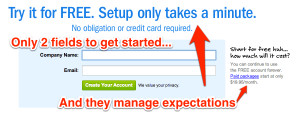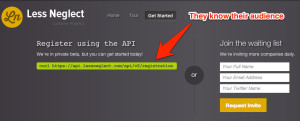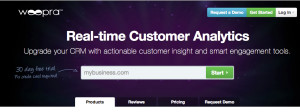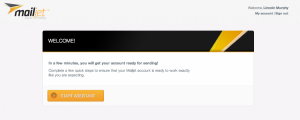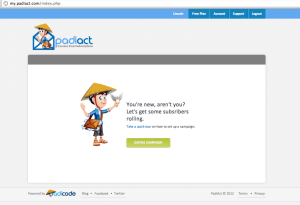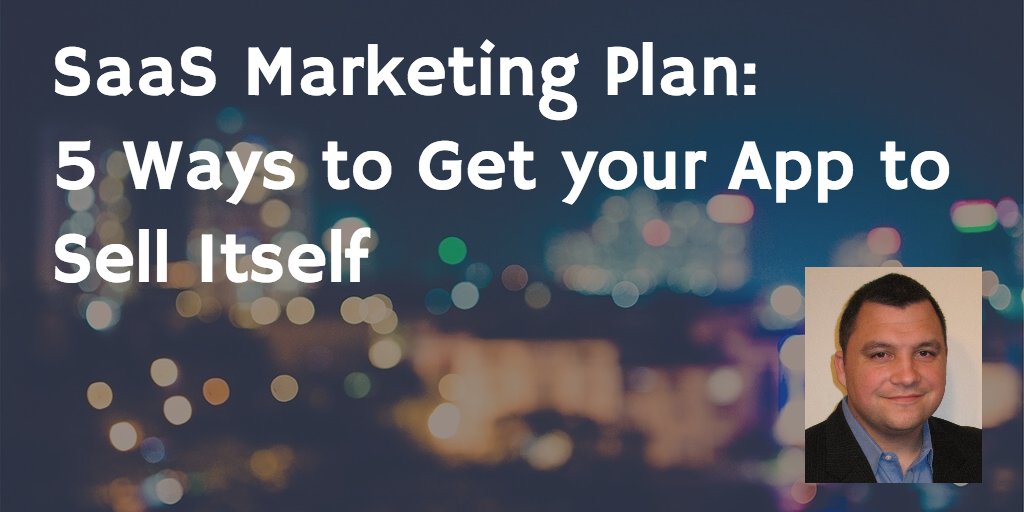
When creating your SaaS marketing plan, you must understand that your business model of choice is a fully-integrated architecture where all aspects of the business – product, support, revenue model, and marketing – are tightly-coupled.
Deviation from that model and understanding will affect growth, and most deviation occurs as a rift between marketing and product.
“The aim of marketing is to know and understand the customer so well the product or service fits him and sells itself.” – Peter Drucker
What Drucker says is even more powerful when you consider your product to be part of your SaaS marketing plan.
And in SaaS, your marketing / promotion / customer acquisition methods must extend into the product in order to get the product to “sell itself.”
SaaS Marketing Plan Goal: Scale Your Sales Process
In fact, you need to think this way whether you have a $10/mo product where the economic buyer is also the end user… or if you have a product that is $500 per user per month, is a complex sale with multiple buyer types, and your average deal size is 1,000 users.
Getting your product to “sell itself” will allow you to scale your sales process efficiently no matter what that sales process looks like!
But, to get your product to sell itself, you have to spend as much time, energy, resources, and/or money on the Customer Acquisition, Retention, and Viral Expansion processes as you do on the core functionality of your product.
Blasphemy to many…. the gospel to the successful!
That said, here are 5 things (of many, but we’ll start here) that you should do to get your app to “sell itself.”
1. Attract the Right Audience
I recently published three posts on promoting your SaaS product and generating relevant traffic… you should read them and watch the video presentation on traffic generation:
- Ideal Customer Profile Framework
- SaaS Sales Funnel: Stop Optimizing for the Wrong Customers
- 100 Places to Promote your SaaS or Web App (Part 1)
- 100 Places to Promote your SaaS or Web App (Part 2)
- 43 ways to get quality prospects to your marketing site
It’s pretty simple, really… nothing else you do matters (conversion rate optimization, Free Trial optimization, better sales people, etc.) if you fail to attract the right audience in the first place.
Make sure you know who you need to be targeting (if you’re going to say “but everyone is a potential customer” save it for the bankruptcy judge) and use this to formulate your advertising and promotion campaigns, your overall look and feel, and even the way your product is designed.
Whether it is in the keywords you target with your SEO, the sites you write guest-posts for, or the sales copy you write, if you’re not speaking to the audience who will likely become your customer, then you are wasting your time, energy, effort, resources… and money.
But assuming you attract the right audience, you need to make sure you…
2. Properly Manage Expectations
This couldn’t be simpler but so many SaaS providers fail miserably at this.
They work diligently to get people to sign-up for Free but fail to let them know that they’re signing up for a limited version, a time-limited Trial, or that at some point there’s a premium version they have to or should pay for later.
If you have a non-refundable setup fee… say that. If you require a credit card to start your trial (but bury that in step 3…), say “valid credit card required” up front.
Many times the mis-management of expectations is reflective of the founder or executive team behind the SaaS company trying to avoid selling, hoping that once the user signs-up and experiences the awesomeness of the product, they’ll just trip over themselves to pay for the product (newsflash: they won’t, at least not after the early adopters).
Other times it’s an unscrupulous owner or executive team that’s trying to trick someone into signing-up for free, not telling them that they’ll have to pay later, and hoping that get’s ’em to become a customer.
Most of the time it isn’t either of those but that the SaaS provider simply doesn’t understand psychology or look at things from the Point of View (POV) of the customer… if you think something is free to use forever and then get hit with a pay wall or an upgrade/nag screen or some artificial feature/usage ceiling – and this is incongruent with expectations – you wouldn’t react favorably by pulling out your credit card… you’d leave, right?
So why would you expect any different from the customers who pay your salary, pay your bills, and are going to make you rich? You shouldn’t… and not understanding these things will hurt your customers, hurt your ability to pay those bills, and keep you from getting rich!
Oh.. and what about sales people calling right after your prospect signs-up for a trial or downloads a white paper? Look at this from their POV.
If you don’t manage expectations that someone is going to call, and they go through what appears to be a self-service process to try your product for 30 days, your prospect will likely NOT enjoy receiving that call the next day.
Now, if you’re going to ask for their phone number because you’re going to call… tell ’em that Steve, their Account Success Rep, is going to call tomorrow around 10AM.
Be bold but be honest.
Okay, assuming you properly manage expectations, then you need to…
3. Remove Barriers to Sign-up
People like to think that the more hoops someone has to jump through to sign-up for your product, the more likely they are to become a paying customer, right? If you say yes, save it for the bankruptcy… oh, I already said that.
NO! Supposed “qualification barriers”, artificial friction, even requiring Credit Cards to sign-up for a Free Trial do nothing but keep potential customers out.
The evidence – the data – clearly shows that reducing the number of fields on your sign-up form can have a dramatic effect on getting people in the door.
Here are some examples of companies that have reduced the FIRST STEP to just a couple of data points… often just a single one!
Please note… looking at pretty pictures of sign-up forms without knowing whether or not 1) this is is the failing part of an a/b or multivariate test or 2) seeing the actual metrics derived from this form can be hazardous to the health of your business. In other words, don’t copy others; observe their behavior and test it for yourself.
Freshbooks continues to refine their sign-up form and are down to just two data points as I write this – email and company name. I assume “company name” is there as a reminder that this is really for businesses (even small ones) and, of course, they use that to personalize the next screen, set the subdomain, etc.:
LessNeglect knows their audience and even lets people sign-up for their beta via API:
Woopra understands that they can get you started with just your URL because they know the psychological principle that Dr. Robert Cialdini, in his book Influence, calls the rule of Commitment & Consistency. They know that rule will lead to a large number of folks continuing the sign-up process on the next screen since they’ve taken an action and are more likely to take a second action.
That same principal is behind this Billion Dollar sign-up form from Yammer: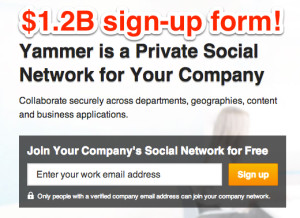
Someday I’ll talk about how Yammer built a $1B+ business (Microsoft acquired them in 2012 for $1.2B) with only a single data point required to get started.
In the meantime, consider that fact the next time you think talking about your sign-up form is just for the “web people” and isn’t relevant to building a real business!
Okay, so I showed you some good examples of companies lowering the barrier to get started… what about bad ones? They’re everywhere!
There are tons of bad examples… you can find them pretty much anywhere.
You’ll recognize them instantly… they have long initial sign-up forms, they ask for information the vendor will not actually use, etc. You know what I’m talking about… in fact, you probably have one.
One rule of thumb I use is this… don’t mark fields as required… If a field is not required, remove it from the initial sign-up form. You can ask for it later in the engagement process.
In fact, only ask for data points up front that are truly required (do you have to call ’em to get started? No? Why ask for the phone number up front, then?
Remember, you can build a customer profile over time (the beauty of a SaaS and a data-driven engagement process).
Whatever you do, my advice is to spend your time and energy getting people into your app and using the service…
…not looking for ways to keep people out or from getting engaged with the service as fast as possible.
In fact, your app should actively…
4. Drive Engagement & Investment
This is the opposite of letting people kick the tires and fend for themselves; or the “strategy” employed by far too many SaaS providers.
Engagement actually starts before they sign-up by getting them excited to use your SaaS product.
I know, I know… marketing fluff, right?
Wrong… that’s the attitude of failure!
There are some great ideas for driving engagement & investment in the SaaS Marketing: 21 Growth Hacks to Test Today guide.
Marketing is the most important thing to your success… but marketing isn’t advertising, it isn’t a fancy slogan or neat graphics… it’s really everything that you put out from your business to your customers – including your product!
So getting them excited up front is just one part of the puzzle… everything that happens from there is super important, too.
In most cases, as soon as the potential customer – who is now excited to try out the app – hits the sign-up form… the momentum slows (see “remove barriers to sign-up” above).
And it just gets worse from there.
They finally get into your product after a long sign-up form, a trip to their inbox to validate their email address, and another login form… and they’re met with something that looks like these (all branding removed to protect the guilty):
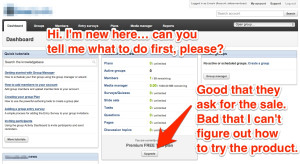
or this…
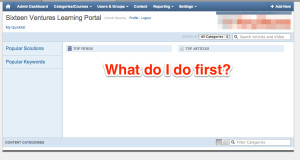
or this…
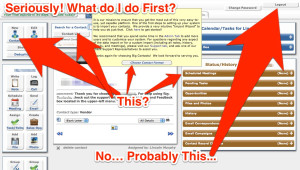
Your first in-app experience shouldn’t cause your potential customer or your new customer (if they bought without trying first) to go “I’m in… so, what do I do now?”
Here’s a good one from MailJet…
Or this one from PadiAct…
I know… those are Wizard-y, huh? You don’t like Wizards? So? Are you the customer? Will it help the customer? Get out of your own way, then, and do what needs to be done.
Now, that said, you have to know your audience… some products need to get out of the way (seemingly) and let the user just poke around… consider products like Twilio that appeal to developers… they “get out of your way” but in a way that still produces a lot of engagement and investment.
On the other hand, a product that is targeting non-technical SMBs… you should probably hold their hand the entire way.
I know that a natural reaction to hearing what I just said is “but if we use a ‘wizard’ the user won’t see all the cool features we offer’ to which I would remind you to read the SaaS rule of Engagement: Confused Minds don’t Buy… they Bounce!
Whatever you do, you must engineer and design the process to take them from sign-up to first in-app experience to engaged user to invested user to paying customer – the entire process, not just part of it – if you want to succeed at scale.
Engagement (something leveraging Common Conversion Activities (CCAs) can help you actually measure and improve upon) is the goal, whether in a Free Trial, for a new paid customer, or a Freemium user.
Some people call the engagement phase “on-boarding,” but I think that term takes the customer out of the equation and focuses on functionally getting them started.
Engagement requires on-boarding, but on-boarding does not require (or guarantee) engagement.
Let me be 100% clear… it is up to you to drive engagement using whatever channels make sense.
This means using email (sorry kids, this is still super-relevant even today LOL), in-app messaging, account reps, or whatever makes sense to get them into (or back into) the app and using it.
And of course, once you have them Engaged, the goal is to drive Investment in your service; investment in the form of time, effort, energy, resources, data, etc… not necessarily money, especially if we’re talking about Free Trials or the free-side of Freemium… Getting them Invested makes conversion to your premium offering a no-brainer.
And from their POV, converting should be a no-brainer when you…
5. Make it Easy to Buy
I can’t tell you how often in a Free Trial it is easier to submit a feature request than it is to become a paying customer!
It’s as if the SaaS provider doesn’t actually want my money.
That speaks VOLUMES about the mindset of the people behind the SaaS product, right?
Remember, unlike the old days of software, the sales process (or funnel) isn’t decoupled from the app… with SaaS, they are one in the same.
Your app needs to actively sell itself to the customer as much as the marketing site, your sales people, etc.
Conversion must be engineered into the product and you have to be willing to ask for the sale. And don’t forget… you don’t have to wait until the end of a Free Trial to ask for the sale.
In fact you should ask for the sale as soon as the prospective customer (not trialist, not user, but PROSPECTIVE CUSTOMER) completes their CCAs.
And of course, you have to sell how your customers buy so consider that when making it “easy to buy” within the app!
Bonus: Make it Easy to Share
Viral Expansion Loops – both internal within an organization/account and external with distributors, trading partners, colleagues, friends, family, social networks, etc. – are critical to getting a product to “sell itself.”
I included “Orchestrated Virality” as one of the 21 Growth Hacks that you could test today.
Or check out this article about optimizing your Referral / Invite a Friend system.

